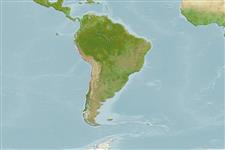Elasmobranchii (tubarões e raias) (sharks and rays) >
Carcharhiniformes (Ground sharks) >
Atelomycteridae (Coloured catsharks)
Etymology: Schroederichthys: In honor of American ichthyologist William C. Schroeder (1895-1977), Woods Hole Oceanographic Institution, for his pioneering work (with Henry B. Bigelow) on cartilaginous fishes; ichthyos (Gr.), fish. (See ETYFish); chilensis: -ensis, Latin suffix denoting place: Chile, described from the Pacific of Chile (and Peru). (See ETYFish).
More on author: Guichenot.
Environment: milieu / climate zone / depth range / distribution range
Ecologia
marinhas demersal. Subtropical; 9°S - 51°S
Southeast Pacific: Peru and Chile.
Tamanho / Peso / Idade
Maturity: Lm ? range ? - ? cm
Max length : 62.0 cm TL macho/indeterminado; (Ref. 244)
An inshore shark found on the continental shelf. Oviparous (Ref. 50449). Sexual dimorphism is evident in dentition of male species (Ref. 49562).
Life cycle and mating behavior
Maturities | Reprodução | Spawnings | Egg(s) | Fecundities | Larvas
Oviparous, paired eggs are laid. Embryos feed solely on yolk (Ref. 50449). Males have longer teeth with fewer cups than females (Ref. 51093) to make 'courtship biting' more effective (Ref. 49562).
Compagno, L.J.V., 1984. FAO Species Catalogue. Vol. 4. Sharks of the world. An annotated and illustrated catalogue of shark species known to date. Part 2 - Carcharhiniformes. FAO Fish. Synop. 125(4/2):251-655. Rome: FAO. (Ref. 244)
Categoria na Lista Vermelha da IUCN (Ref. 130435)
Ameaça para o homem
Harmless
Utilização humana
Pescarias: sem interesse
Ferramentas
Relatórios especiais
Descarregue XML
Fontes da internet
Estimates based on models
Preferred temperature (Ref.
123201): 10.2 - 13.2, mean 11.3 °C (based on 40 cells).
Phylogenetic diversity index (Ref.
82804): PD
50 = 0.5312 [Uniqueness, from 0.5 = low to 2.0 = high].
Nível Trófico (Ref.
69278): 3.5 ±0.5 se; based on diet studies.
Resiliência (Ref.
120179): Muito baixo, tempo mínimo de duplicação da população maior que 14 anos (Fec=2).
Fishing Vulnerability (Ref.
59153): Moderate vulnerability (45 of 100).
Nutrients (Ref.
124155): Calcium = 27.5 [4.5, 149.5] mg/100g; Iron = 0.744 [0.202, 2.283] mg/100g; Protein = 15.9 [13.0, 20.3] %; Omega3 = 0.205 [0.091, 0.441] g/100g; Selenium = 25.5 [7.7, 71.1] μg/100g; VitaminA = 10 [3, 28] μg/100g; Zinc = 0.657 [0.315, 1.206] mg/100g (wet weight);
